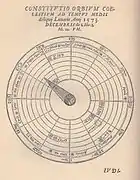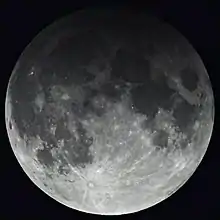| Total eclipse | |||||||||||||||||
 | |||||||||||||||||
| Date | December 8, 1573 | ||||||||||||||||
|---|---|---|---|---|---|---|---|---|---|---|---|---|---|---|---|---|---|
| Gamma | 0.1620[1] | ||||||||||||||||
| Magnitude | 1.5597[1] | ||||||||||||||||
| Saros cycle | 118[1] (27[1]) | ||||||||||||||||
| Totality | 1h33m31s[1] | ||||||||||||||||
| Partiality | 03h33m15s[1] | ||||||||||||||||
| Penumbral | 5h30m46s[1] | ||||||||||||||||
| |||||||||||||||||
A total lunar eclipse occurred on December 8, 1573.
It was predicted and then observed by a young Tycho Brahe (assisted by his sister Sophia) at Knutstorp Castle. He said "I cannot but be very surprised that even at this youthful age of 26 years, I was able to get such accurate results."[2]
- Eclipse visibility diagrams

 The moon passed west to east through the center of the earth's umbral shadow causing a very dark red eclipse
The moon passed west to east through the center of the earth's umbral shadow causing a very dark red eclipse Diagram of the appearance of the eclipse from Tycho Brahe's De nova stella
Diagram of the appearance of the eclipse from Tycho Brahe's De nova stella Diagram of the solar system at the time of the eclipse from Tycho Brahe's De nova stella
Diagram of the solar system at the time of the eclipse from Tycho Brahe's De nova stella
See also
References
External links
- Curriculum vitae of Tycho Brahe Tycho observes a lunar eclipse together with his 17-year-old sister Sophie. From the observation he finds the perigee of the Sun.
- Sophie Brahe, 1556-1643
- Brahe, Tycho, Complete Dictionary of Scientific Biography
- NASA graphics
This article is issued from Wikipedia. The text is licensed under Creative Commons - Attribution - Sharealike. Additional terms may apply for the media files.

_(cropped).jpg.webp)
